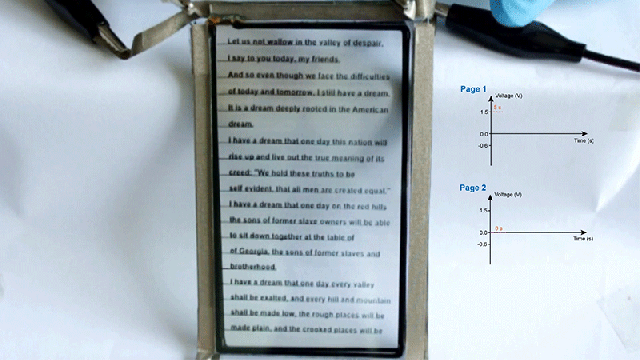Researchers at Jilin University in Changchun, China, have come up with a method for making transparent displays that look as good as the screens on our mobile devices, with colour reproduction and contrast levels that could soon have us permanently ditching smartphones and tablets for smart glasses.
Transparent displays are far from a new idea. Science fiction has been presenting us with see-through smartphones and vibrant mixed-reality headsets for years. It’s hard not to lust after the mobile devices Tony Stark gets to play with, but while the technology exists in real life, it’s mostly used for novelty or advertising purposes. Companies like LG sell transparent OLED displays for use as signage, but not as a replacement for your living room TV. Non-emissive see-through screens don’t generate their own light, but instead rely on ambient light passing through or bouncing off the display, and don’t have the same contrast levels, viewing angles, and colour reproduction capabilities as LCDs or OLEDs.
[referenced id=”1053478″ url=”https://gizmodo.com.au/2017/07/google-glass-is-officially-back-doing-something-it-doesnt-suck-at/” thumb=”https://gizmodo.com.au/wp-content/uploads/2017/07/19/sg349zildk3mwqtb9lps-300×169.jpg” title=”Google Glass Is Officially Back, Doing Something It Doesn’t Suck At” excerpt=”Google has officially announced what we’ve known for two and a half years — Google Glass isn’t dead, the company has just been redeveloping the technology for the enterprise sector and, specifically, blue-collar manufacturing workers.”]
Anyone who had a chance to use Google Glass while it was available to consumers knows the limitations of transparent displays, but while image quality lacks, the technology is crucial for creating smart glasses, which many assume will one day supplant smartphones.
There’s little doubt that deep in the R&D labs of giant corporations like LG and Samsung, researchers are trying to find ways to improve transparent OLEDs, but the Chinese researchers at Jilin University may have beaten them to the punch. In a paper published in the journal Chem today, the team details a new approach to electrochromic displays that change colour and opacity by manipulating the properties of light when a voltage is applied.
A prototype was created by essentially building a glass sandwich with a pair of clear panels that were injected with a material made from “metal salts, dyes, electrolytes, and solvent” in addition to electrodes, with the whole thing held together using an adhesive that doubled as a spacer. When a voltage is applied, the metal ions and molecules in the filler form new bonds and structures that essentially cause the dyes to switch on and off. As different dyes are activated and mixed, the researchers found that colours including cyan, magenta, yellow, red, green, pink, purple, and grey could be produced. The display could easily shift from fully transparent to black with a high contrast ratio, which is crucial for displaying legible text.
The new non-emissive screen technology is also relatively low-cost and easy to manufacture, further increasing its chances of replacing LCDs and OLEDs in applications like smart glasses, but first the researchers are hoping to optimise its performance. It can shift from transparent to displaying text or imagery in less than a second, but that’s not quite fast enough to match the performance of screens used on smartphones or wearables. It’s going to need to be able to switch states at at least 30 times every second before the technology is practical enough to replace what we’re using now. No one’s going to want a pair of smart glasses if they can’t secretly watch YouTube videos while they look like they’re paying attention to a meeting or class.
